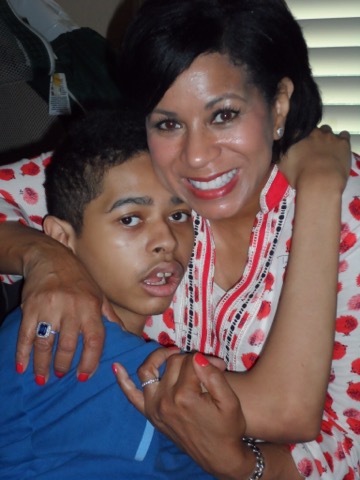The story of Juli Henderson
Robert had a mitochondrial disorder that involved a variety of body systems including the brain and muscles (causing all types of seizures, poor stamina, muscle weakness, lack of muscle tone), and the nervous system (heat intolerance, excessive sweating). His symptoms became especially severe during ordinary infections, often with ordinary exercise, and with excessive heat or humidity. Later in his life, genetic testing revealed that he also had a gene alteration that predisposed him to seizures and developmental disorders. Robert’s disease was progressive, and he was eventually diagnosed with cerebral palsy, autism, and mental retardation (MR) or intellectual disability (ID). Attempts to control his hundreds of seizures would, sometimes, mean spending days in the hospital.
Robert’s wonderful medical team, under the direction of pediatric neurologist Dr. Karen Keough, treated Robert for most of his life. His treatments included every avenue possible to lessen his seizures and regression. He was prescribed almost every new epileptic medicine available, many years combining three to five anticonvulsants at a time just to keep him seizure free for a few hours at a time. Robert had a g-tube, corpus callosotomy (brain surgery), VNS (vagal nerve stimulator), and remained on the Ketogenic Diet for several months at a time throughout his lifetime. His language was very sparse, but he found ways to communicate through gestures.
Mitochondrial disease has no apparent therapies because energy cannot be therapeutically applied in a direct way. Robert was treated with vitamin therapy, nutrition support, and developmental/educational stimulation. We worked hard to prevent infections, and monitored him constantly for potential, treatable complications.
His school and all therapies (speech, occupational, physical, behavioral) became a homebound priority. He had skilled nursing care for most of each day, and he required an enclosed Posey bed to keep him safe at night because of his seizure activity. Protective medical helmets were also necessary and helpful, as his drop seizures increased. As a teenager, he became wheelchair bound, but managed to keep one to two iPads working on his wheelchair tray at all times!
Robert passed away at age 18. A few months before he passed, my husband, Robert and I underwent genetic testing. Dr. Keough and Robert’s geneticist, Dr. James Gibson, informed us that Robert’s mitochondrial disease stemmed from a genetic diagnosis of CHD2 epileptic encephalopathy. This detailed diagnosis was based on the testing we did before Robert passed, but was completed only after his death. Prior to this diagnosis, Dr. Keough simply called it “Robert’s disease” because his disease was extremely rare.
We are forever grateful that his doctors recommended that the blood work take place at that time in his life, as it would not have been possible a few months later. This diagnosis was crucial information for our other children who were concerned that such a genetic condition could be passed down through to their families. Thankfully, this is not the case.
During his short life, Robert was most known for his big, toothy smile, and his all-embracing hugs. His capacity to give and receive love was deeply beyond measure.
